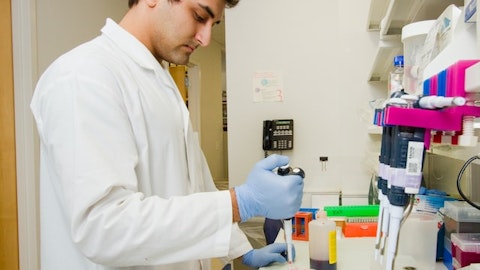ImmunoPrecise Antibodies Ltd. (NASDAQ:IPA) Q2 2024 Earnings Call Transcript December 14, 2023
ImmunoPrecise Antibodies Ltd. beats earnings expectations. Reported EPS is $-0.07, expectations were $-0.09.
Operator: Good morning, ladies and gentlemen. Thank you for joining us today for IPA’s Earnings Call covering the Second Quarter of Fiscal Year 2024. I am Sarah and I have the privilege of hosting this call. Before we commence, I would like to draw your attention to the fact that our discussion today may include forward-looking statements. These statements are subject to various risks and uncertainties that could cause actual results to differ materially from what we express or imply. We strongly encourage you to review our filings with the Securities and Exchange Commission for a comprehensive discussion of these risks and uncertainties. IPA remains committed to complying with legal requirements and will update forward-looking statements only as mandated by law.
During today’s conference call, as well as in the accompanying presentation slides, we will be employing non-GAAP financial measures to assist investors and analysts in comprehending IPA’s business performance. Adjusted EBITDA in particular allows for meaningful comparisons and analysis of trends in our business over different periods. For a detailed explanation and reconciliation of these non-GAAP measures to GAAP measures, please refer to the Management Discussion and Analysis Section of our filing on EDGAR and SEDAR. Now without further ado, I would like to pass the floor to IPA’s CEO Dr. Jennifer Bath, who will provide an overview of our quarterly results.
Jennifer Bath: Thank you, Sarah. Good morning, everyone, and thank you for joining us. IPA has consistently invested in its end-to-end antibody services, encompassing discovery through development, aimed at reducing the risk, cost, and time needed to bring novel therapies to the clinic. Reflecting on the effectiveness of this approach, the company’s second quarter financial and operational results reveal a third consecutive record quarter with revenue of $6.2 million. This number represents an 18.6% increase above the same period last year. We continue to see strong growth across several areas of our service offerings, including our laboratory B-cell select platform and our manufacturing facility with its expanded capacity. Importantly, our strategic efforts have enabled us to be successful in growing revenue while also reducing our cash burn from $1.6 million in our first quarter of this fiscal year to $700,000 this quarter.
Our subsidiary, BioStrand, recognized approximately $165,000 of early revenue this quarter, stemming from LENSai-driven client programs as they continue to progress toward the next phase of their launch of their LENSai portal and software as a service or SaaS platform. With our Talem assets, we remain committed to our strategy of driving revenue through out-licensing opportunities. I am excited to share with you today an update on one of our Talem assets that was highlighted in September’s earnings call. We have recently received and executed a letter of intent to engage in a material transfer agreement for that asset. We also continue to leverage Talem’s other previously announced strategic partnerships, which are contributing to our contract research revenue and generating new client opportunities for BioStrand.
The macro environment for the drug discovery industry continues to be challenging. Industry-wide biotech funding is down over 60% from its peak in 2021. It is against this backdrop that we are especially pleased with our consistent revenue growth during a time when many of our peers are reporting significant revenue decline. You may ask, why is IPA bucking that trend? We believe that there are several reasons why we are outpacing that industry trend. First, as indicated, many of our pharma and biotechnology clients are looking to consolidate their R&D with vendors that they know and trust, and who have made the investments in technologies of the future. As a result, given our breadth of services, we are capturing additional wallet share from some of our largest clients.
Second, having expanded our manufacturing footprint in Europe to meet our clients’ needs, we continue to see increased demand in our antibody manufacturing capabilities. Coupled with our industry-leading B-cell select offering and based on client conversations and ongoing sales orders, which are up 83% over the same quarter last year, we are optimistic the trend in our revenue growth will continue. In this turbulent financing market, we have focused on enhancing operational efficiencies and enforcing strategic budget reductions to manage our cash burn. As demonstrated by our consistent revenue growth over the last quarters, our cost-cutting efforts were carefully executed to support our long-term goals without compromising our growth or operations.
This has included a strategic reduction in non-ROI generating employees over the past 12 months, a decision made to streamline our cost structure, while maintaining our business’s momentum and effectiveness. Our financial results reflect the success of these measures. In these first two quarters, we’ve seen $10.6 million reduction in operating expenses compared to the previous year. This has been achieved in part by the completion of investments in our Talem assets and without impacting the positive cash flow generated by our laboratory division. These budget cuts are not just about reducing costs. They represent the philosophy that we have had for many years to continue to evaluate and evolve to meet both the needs of our clients, to remain at the forefront in our field, and to be pragmatic as the macro environment continues to evolve.
By concentrating our investments in these areas with the highest potential returns, we are positioning ourselves for long-term growth and enhanced shareholder value. I would like to take a moment to discuss the progress, strategy, and goals of our non-laboratory subsidiaries. The BioStrand business we acquired in April of 2022 possessed highly differentiated underlying technology, but was relatively early in its commercialization efforts. Since the acquisition, we have committed resources and made significant progress toward building commercial products. We believe we are in a very different position relative to many other AI and bioinformatics companies in our industry. Our wet lab have over 600 pharma and biotechnology clients, including 19 of the top 20 global pharma companies.
We have decades long relationships with many of the most important companies in the industry. We know our clients workflows, and we understand what they demand from a scientific standpoint. The software product BioStrand is developing are designed to meet these needs. To put it bluntly, we believe we are building AI products that our industry partners actually want and need, unlike many other AI companies in the healthcare industry. BioStrand plans to roll out its AI software to existing clients with secure portal access, offering an array of in-silico tools and additional analytical services to further analyze their data from IPA programs. The initial focus is on seamlessly introducing clients to this platform with an emphasis on providing value and utility through advanced and silico discovery services.

The gradual integration of clients is designed to familiarize them with the platform’s capabilities, setting the stage for upselling more sophisticated services and tools. The SaaS model is being designed to ultimately encompass comprehensive data management and analytical tools, making it accessible to a wider audience beyond the initial client base. This broader public rollout will follow the initial client centric launch, ensuring that the platform is thoroughly tested and refined based on initial user feedback. This dual approach, starting with a targeted client introduction followed by a broader SaaS rollout, is designed to ensure seamless integration into existing customer workflows. It allows BioStrand and IPA to collect critical feedback from early users, which is invaluable for the ongoing development and optimization of the platform.
The goal is to support profitable growth while continuing to enhance the platform’s capabilities to meet the evolving needs of clients in the dynamic field of drug discovery and development. Much of our historical cash burn is attributable to our investments in R&D, particularly those in the therapeutic assets for Talem. It is important to note that we’ve completed our significant investments several quarters ago, and our current focus is now on exploring avenues to monetize these assets. As indicated during our fiscal 2024 Q1 earnings call, Talem engaged in discussions with an interested party regarding the potential therapeutic candidate for an incurable progressive disease. Based on the partner’s review of Talem’s most recent data, we’ve received and executed a letter of intent to enter into a material transfer agreement within a six-week period.
The MTA enables the partner to conduct an in-house review of the asset that is under contemplation for an out-licensing, as well as exclusive rights to the asset during the duration of the agreement. The future of drug discovery is evolving toward the integration of the in silico or computer-based and wet lab processes through comprehensive integrated solutions providers. Recognizing this trend early, the company has already invested in aligning its operations accordingly, anticipating that these proactive investments will yield long-term value for our investors. Now at a significant turning point, IPA welcomes strategic leadership changes and policy implementation. Mitch Levine, our new board Chairman, brings valuable experience from his roles in the life science industry, as well as financial management.
Joining him are Dr. Barry Springer, Dirk Witters, and Chris Buyse, enhancing the board’s expertise in biotech innovation, finance, and public life sciences, respectively. These appointments, along with recently adopting our new majority voting policy, demonstrate our commitment to strong governance and shareholder engagement. Now, I’d like to turn it over to our Chief Financial Officer, Kristin Taylor, to discuss our financials in further detail.
Kristin Taylor: Thank you, Jennifer. I’ll provide a brief overview of our financial results for the second quarter before touching on our financial position as of the end of the period. As a reminder, all numbers I reference are in Canadian dollars, unless otherwise noted. Starting with our revenue, for the three months ended October 31, 2023, we achieved revenues of $6.2 million, representing a 19% increase from our revenue of $5.2 million in Q2 of the previous year. Our year-to-date revenue for fiscal 2024 was $11.8 million, reflecting a 20% increase from fiscal 2023 year-to-date revenue of $9.9 million. Supporting this growth, our Utrecht, Netherlands site achieved year-to-date revenue growth of 43% year-over-year and is benefiting from expansion efforts in Q3 of last year.
Our Victoria, BC site achieved year-to-date revenue growth of 17% year-over-year, and will be expanding in early calendar 2024. We’re seeing the impact of these expansion costs on our gross margin, along with the new BioStrand revenue, which in its early stage of limited commercialization has lower margins than those targeted at full rollout. We’re also seeing the impact of inflation and we are reviewing pricing changes for the start of the calendar year as part of our overall initiatives to bolster gross margin. Now on to our operating expenses. Our research and development expenses for the second quarter were approximately $1 million, representing a $4 million decrease over the same period of the previous year. This decrease reflects the completion of the investments required to build the Talem assets and now primarily represents our investment in supporting the phased rollout of our BioStrand offerings.
Sales and marketing expenses for the quarter are up approximately $100,000, in line with our rising revenues. And general and administrative expenses for the quarter are $3.3 million compared to $3.8 million for the second quarter of the previous year. This reduction reflects our strategic cost cutting efforts onto earnings per share. Our growth in revenue and reduction in expenses resulted in a net loss of $2.6 million or a loss of $0.10 per share for the quarter. This compares to our second quarter of fiscal 2023 that resulted in a loss of $7.4 million or $0.30 per share loss. Along with this reduction in net loss, we also experienced a reduction in our overall cash burn. This reduction in cash burn supported us in finishing the second quarter of our fiscal 2024 with unrestricted cash of $6 million versus the previous quarter end of $6.7 million and our fiscal 2023 year-end balance of $8.3 million.
Based on this reduced cash burn, we believe our cash position is sufficient to operate our business through the second quarter of fiscal 2025. Additionally, subsequent to the end of our second quarter, on December 8, 2023, we closed on an underwritten public offering of 1,265,000 common shares with estimated net proceeds of approximately 1.1 million. While it is currently a challenging and high cost equity environment for life science companies, we initiated the small common stock raise to address current customer demand for additional wet lab capacity and to provide additional R&D for our higher growth BioStrand initiatives, both of which we believe support long-term value creation above the cost of capital. With that, I’ll turn it back to Sarah for Q&A.
Operator: Thank you, Kristin. Before Jennifer adds any closing remarks, we would like to open the floor to any questions from analysts and investors. [Operator Instructions] Your First question comes from the line of Arthur He with H.C. Wainwright. Your line is open.
See also 9 Quantum Computing Stocks Billionaires Are Piling Into and 13 Most Promising Gold Stocks According to Analysts.
Q&A Session
Follow Immunoprecise Antibodies Ltd.
Follow Immunoprecise Antibodies Ltd.
Arthur He: Hey, good morning, everyone. This is Arthur on for RK. Thanks for taking my question. So the first question is regarding the rollout of the LENSai portal. Before you taking that to all IPA clients right now, what additional steps or effort you need to complete before the rollout?
Jennifer Bath: Thank you for your question. This is Jennifer. I’m happy to answer that question. So first of all, one of the things that is being done here is, we are still adding a couple of features to that portal for the client rollout, as it will have numerous features that the clients can use to analyze the actual data that they’re getting from all of our different web lab sites globally. We’re also testing that portal internally across multiple sites to make sure that we’ve basically removed any bugs or any challenges that could exist during the client rollout so that we know that it’s entirely ready for that push out to our clients. Aside from that, we’re actually getting fairly close to having the final portal available for the client. So it’s part of the front end user capabilities and being ready to push that in a secure environment with the username and passwords for our clients to access it.
Arthur He: Got you. Thanks. So within that, in the background, how we should expect the public launch for the SaaS platform, is still within the estimate you guys provided for it, which probably is in the second half of next year?
Jennifer Bath: Yes. So yes, we are still on track for the same dates that we previously provided. And how we envision that is, after the portal has been in use by our existing clients, we will continue to add additional features through that portal, as well as advertising the ability for those clients to come in directly for the fee-for-service capabilities for more complex programs. And then we will roll out that SaaS platform, which is essentially a much more sophisticated version of the portal, both to our clients and then to the public. And again, just to re-emphasize that the SaaS platform in and of itself is also managing our capability for data management and data organization, while also giving access to LENSai to our clients. And as just previously mentioned, yes, that continues to be on target for the previous time frame we have provided.
Arthur He: Awesome. Thanks for taking my question. Congrats on the rollout.
Jennifer Bath: Of course. Thank you.
Operator: Your next question comes from the line of Will McHale with Ingalls & Snyder. Your line is open.
Will McHale: Good morning, Jennifer and Kristin, and congrats on the solid set of financial results.
Jennifer Bath: Thank you.
Will McHale: To start, I guess just looking back at the performance of the company over the past 12 or 18 months, there have been a number of things that have been discussed on the conference call, things such as expectations around out-licensing deals and time to ramp revenue from BioStrand partnerships that haven’t fully materialized as the company expected initially. If you were to kind of give a postmortem or look back on why things haven’t exactly materialized as expected, what would be the explanation?
Jennifer Bath: Thank you. Thanks for asking that question, Will, because I suspect that you’re not alone in having that question with regard to BioStrand partnerships and out-licensing expectations for Talem. And so, while there’s probably a couple of different factors, I think there’s one key factor that we definitely can be confident has impacted those prospects and clients and partnerships. And a lot of that has to do with the undeniable post-COVID market slowdown. We know that it had a very tangible impact on our partners and our clients. We observed a notable shift in their operations. Oftentimes they shared that very directly with us. Many of them temporarily had to pause programs or pause partnerships. Many of those clients also saw consolidation in the industry and many of the pipeline companies either merged or ceased operations or even delayed further investments.
And of course, those pipeline companies are our primary target for these types of opportunities. Additionally, the challenging financial landscapes also made it really difficult for these biotech firms to secure the necessary capital for in-licensing and continuing their research endeavor. So we really saw a significant slowdown in those efforts and a lot more conservative spending as a lot of those pipeline companies kind of halted those activities. However, I think it is important to note also that there are emerging signs of a shift in this trend. We’re beginning to see a gradual resurgence in activities, in conversations and investments in the sector. As indicated, I think, really by the recent letter of intent received by Talem. And the change, even though it is gradual and will be gradual, I think it’s a positive indication of recovery and a return to more robust operations for our partners and our clients.
Will McHale: Thanks, that makes sense. And I appreciate the color you gave in the script about the overall biotech funding environment. Hopefully it’s a change in 2024 as we move forward. A quick question on capital allocation. The company has spent a lot of money on Talem assets and issued a bunch of shares to acquire BioStrand. Looking at those totals now are more than our current market cap, which is sort of depressing to see. But how are you guys thinking about just these investments creating shareholder value? And I guess you can also address the raise last week too. It was a pretty depressed valuation. What are sort of the thought process on ROI with these decisions?





